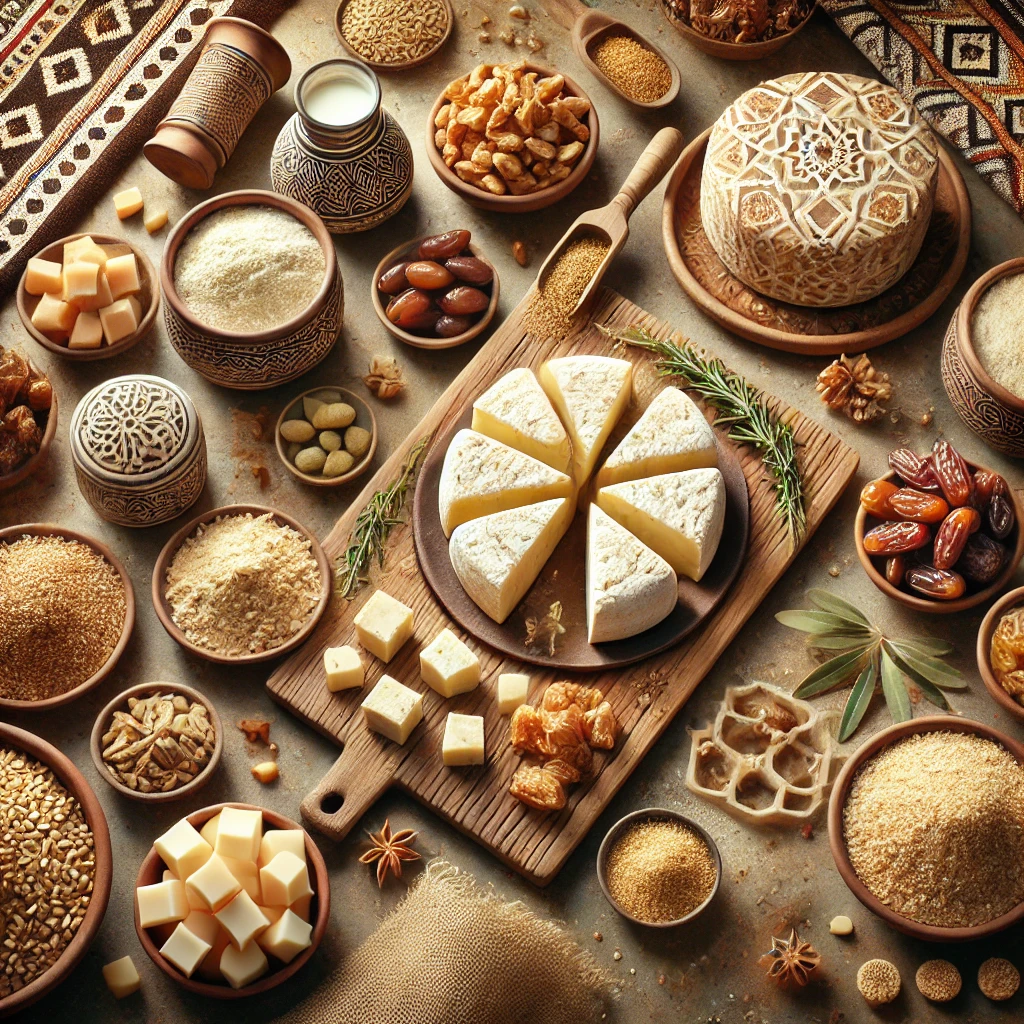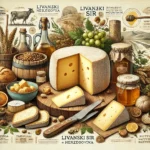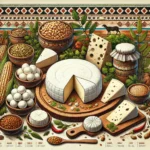Algeria is home to a rich culinary heritage shaped by desert landscapes, mountain regions, and centuries of nomadic life. Among its most fascinating traditional foods is Klila cheese, a rare and ancient dairy product that reflects survival, ingenuity, and cultural continuity.
Klila is a dried, fermented cheese traditionally made in rural and semi-arid regions of Algeria. Unlike soft or aged European cheeses, Klila is valued for its long shelf life, intense flavor, and nutritional density. It is not a commercial cheese but a deeply traditional one, often made at home using time-honored techniques passed down through generations.
Historical Origins of Klila Cheese in Algeria
Klila has roots in Berber and Saharan pastoral cultures, where preserving food was essential for survival. In regions with extreme heat, limited refrigeration, and seasonal milk availability, communities developed ways to transform fresh dairy into long-lasting products.
Milk from cows, goats, or sheep was fermented, churned, and dried, resulting in Klila. This cheese could be stored for months, transported during travel, and used sparingly to enrich meals. For centuries, Klila served as an emergency food, trade item, and protein source, especially during dry seasons.
Cultural Importance of Klila Cheese
Klila is more than food—it is a symbol of self-reliance and resilience. Traditionally prepared by women, Klila represents household knowledge and intergenerational wisdom.
Klila is culturally significant because it:
-
Reflects nomadic and rural heritage
-
Requires no industrial tools
-
Preserves milk without waste
-
Strengthens food security
Even today, Klila is respected as a heritage food, particularly in southern and high-plateau regions of Algeria.
Milk Sources and Ingredients
Klila cheese is traditionally made using soured milk, often after butter production.
Milk Types Used
-
Cow’s milk (most common)
-
Goat’s milk (adds tanginess)
-
Sheep’s milk (richer and denser)
Core Ingredients
-
Fermented milk or buttermilk
-
Natural acidity
-
Time and sun (for drying)
No commercial cultures, rennet, or additives are used.
Traditional Production Process of Klila Cheese
Klila production is a multi-stage process rooted in traditional dairy handling.
Step-by-Step Traditional Method
-
Milk Fermentation
Fresh milk is left to ferment naturally until sour. -
Butter Churning
The fermented milk is churned to extract butter, leaving buttermilk. -
Heating the Buttermilk
The remaining liquid is gently heated, causing curds to separate. -
Draining the Curds
Curds are strained using cloth to remove excess whey. -
Drying
The curds are shaped into small pieces and dried in the sun or air. -
Final Drying and Hardening
Once fully dry, Klila becomes extremely hard and shelf-stable.
This process produces a cheese that can last for months without refrigeration.
Texture and Appearance
| Feature | Description |
|---|---|
| Texture | Very hard, crumbly when grated |
| Moisture | Extremely low |
| Color | White to pale yellow |
| Shape | Small nuggets, balls, or irregular pieces |
Klila is one of the hardest traditional cheeses in North Africa.
Taste Profile of Klila Cheese
Klila has a powerful and concentrated flavor.
Flavor Characteristics
-
Strong sourness
-
Intense dairy aroma
-
Slight bitterness
-
Deep umami character
Because it is highly dried, Klila’s flavor is far stronger than fresh cheeses. It is rarely eaten alone and is usually grated or dissolved into dishes.
Variations of Klila Cheese
Klila is not standardized, so variations depend on region and household tradition.
Cow Milk Klila
-
Sharper acidity
-
Lighter texture
Goat Milk Klila
-
Tangier and more aromatic
Sheep Milk Klila
-
Richer and creamier undertones
Finely Ground Klila
-
Easier to cook with
-
Used as seasoning
These differences highlight local adaptation rather than formal styles.
Traditional Culinary Uses of Klila
Klila is used sparingly due to its intensity.
Common Traditional Uses
-
Grated into soups
-
Dissolved in hot water or broth
-
Mixed with couscous
-
Added to stews for flavor and protein
It acts more like a seasoning cheese than a table cheese.
Modern and Contemporary Uses
While still mostly traditional, Klila is gaining interest among chefs and food historians.
Modern Applications
-
Heritage North African cuisine
-
Protein enrichment in minimalist dishes
-
Culinary research and gastronomy projects
-
Artisanal food festivals
Its uniqueness makes it valuable for preserving culinary identity.
Best Food Pairings for Klila Cheese
Traditional Pairings
-
Couscous
-
Barley or wheat porridge
-
Flatbread
-
Simple vegetable stews
Balancing Ingredients
-
Olive oil
-
Cooked onions
-
Mild vegetables
Neutral foods help balance its sharp intensity.
Beverage Pairings
Traditional beverages soften Klila’s strong flavor.
Beverage Options
-
Mint tea
-
Buttermilk
-
Warm water
-
Light herbal infusions
Strong or acidic drinks are generally avoided.
Nutritional Value of Klila Cheese
Klila is nutrient-dense, designed for survival.
Nutritional highlights include:
-
High protein concentration
-
Calcium and minerals
-
Low moisture content
-
Long-lasting energy
Because it is very dry and intense, small quantities are sufficient.
Klila vs Other North African Cheeses
| Feature | Klila | Jben | Tafoughalt |
|---|---|---|---|
| Texture | Extremely hard | Soft | Semi-firm |
| Aging | Fully dried | Fresh | Fresh/lightly dried |
| Flavor | Very strong | Mild | Mild |
| Use | Cooking/seasoning | Table cheese | Daily meals |
Klila stands apart as a preservation cheese.
Buying and Storing Klila Cheese
Buying Tips
-
Look for very dry, odor-clean pieces
-
Avoid mold or moisture
-
Buy from trusted traditional producers
Storage Tips
-
Store in dry containers
-
Keep away from humidity
-
No refrigeration required when fully dried
Properly dried Klila can last for months.
Why Klila Cheese Matters Today
Klila represents a disappearing knowledge system—how people preserved food without technology. In a world facing climate challenges and sustainability concerns, Klila offers lessons in:
-
Zero-waste dairy use
-
Climate-adaptive food preservation
-
Cultural resilience
As interest in indigenous and traditional foods grows, Klila deserves recognition as a vital part of Algeria’s food heritage.
Conclusion
Klila cheese from Algeria is one of the most remarkable traditional cheeses in the world. Born from necessity, shaped by climate, and preserved through culture, it stands as a testament to human ingenuity and adaptation.
Though rarely seen outside rural communities, Klila remains a powerful symbol of Algerian culinary identity. Exploring Klila is not just about discovering a cheese—it is about understanding how food, culture, and survival are deeply intertwined.
Frequently Asked Questions (FAQ)
What is Klila cheese made from?
Klila is made from fermented milk or buttermilk, usually from cow, goat, or sheep milk.
Is Klila cheese aged?
It is not aged like European cheeses but fully dried for long preservation.
How does Klila cheese taste?
It has a very strong, sour, and intense dairy flavor.
How is Klila traditionally eaten?
It is grated or dissolved into soups, couscous, and stews.
Is Klila cheese widely available?
No, it is mostly produced locally in Algeria and rarely exported.



